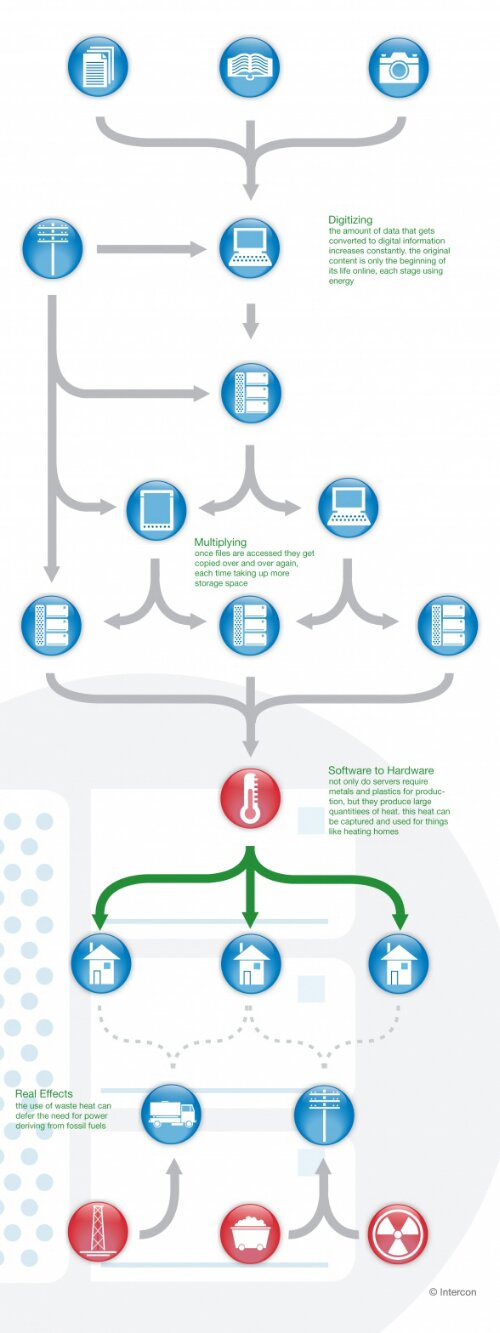A simple question sometimes opens unexpected complications. In this case, what counts for the garbage of the internet?
(tl;dr: It can be tempting to swerve into digressions here about wastes of time or wastes of attention a la cat videos. Sorry – instead, this post focuses instead on the production, distribution, circulation, use and deprecation of those media artifacts, their platforms, and the machines on which we view them.)
One way to approach the question is to ask how we measure the energy efficiency of the internet. The factors that influence that measurement include the rate of electricity consumed by mobile devices and their chargers, personal computers, modems and routers, servers, and data centers. Most significantly, the energy required to cool those machines can stagger the mind. A proper study of this use must also account for the amount of energy invested in the production of the same machines. Efficient consumption of resources serves the interests of the largest discrete consumers and of the utility providers who make the resources available to aggregate consumers, but without discriminating between economic and ecological criteria. For example, GreenPeace’s recent “Dirty Data” report, which embroiled Facebook and other companies in P.R. and legal battles, argues that large IT firms, especially data centers, continue to consume energy in 19th- and 20th- century industrial factory patterns, rather than embracing “clean” energy as wholeheartedly as efficiency. While new facilities constructed over the past few years by Apple, Google, Amazon, and Microsoft certainly deserve their accolades for efficient design. Efficiency, however, only provides one lens onto the original question of garbage or waste.

In a scholar’s ideal world, the proportion of electronic energy consumption that is spent specifically on the generation of content for the internet — in terms of software and media — would have to enter into these equations. But these productive or creative uses of e-resources might also present a contradiction to be managed. On its face, these uses would seem to mitigate their costs, because they give depth and interesting significance to the internet. However, the curious problem of digital waste takes a turn here, because the distribution and circulation of software and digital media relies on replication and deprecation. The latter should come as no surprise, given that a new version of your smartphone has already come out, and that the computer you bought last year is already hopelessly obsolete. We already know that the piles of discarded computers and other electronics growing fast in Ghana, India, and China are Northerners’ outsourced landfills. The environmental, ecological, and public-health stakes of these landfills, and of the scavenger economics that sprout from them, are also on our radar.
But the deprecation of old software and media also exacerbates consume-and-discard cycles. This is because of how we share and save our data. Each time we email (or upload, download, tweet, or post) a photo, document, or program, the data is not moved, but copied. And the data that we need or expect to be reliably available exists on many servers at once, for redundancy or network latency. The iteration of this habit, in billions of operations each second, means that the storage space we consume continually grows. It is manifestly more efficient in short terms to simply purchase more hardware and waste more space than to reconfigure the ways that we manipulate data. Bytes are cheap, and it is far easier to move bits than atoms. So, our architecture favors — and in some ways, requires — this model. After all, we can always send those too-full disks to the landfill.
So we broach the further questions that attend a study of excess online. We begin to find the tools to ask how many must die to build a new computer, and who they are. We can map the paths, across the globe, of deprecated software, hardware, and even networks. We must ask who gets, uses, buys, breaks, discards, scavenges, and recycles internet waste. At that point, we can ask about the cultural values of internet junk, of wastes of time or spent attention. This approach certainly highlights the frivolity of certain investment bubbles, since the value that things like social networks add can be measured against their real operational and ecological costs.
The central question pivots here. It transforms from, ‘what counts for the garbage of the internet,’ to: what does our garbage tell us about our internet? That mode will stick with the following posts in this series, as behavioral and analytical practices take the place of waste-making in the question.